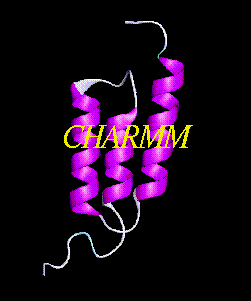Overview of CHARMM version c32b1 .doc Files

Scope
The documentation presented here is that for the latest academic
version of the CHARMM program (Chemistry at
HARvard Molecular Mechanics), as maintained
at the TSRI development site. Quite a few features are contained in
this version that are NOT included in the CHARMm
version distributed by MSI as part of the Quanta package. The
information in these .doc files has been contributed by CHARMM
developers over the years, and hopefully reflects the current state of
the program. The Harvard designation for this version is
c32b1, where "c" refers to CHARMM, 32 is the
version number and the letters g, b or a indicate the release,
i.e. gamma, beta or alpha; Note releases of
gamma and beta codes at TSRI may contain a few bugfixes
and other minor differences and alpha level codes are
development versions.
The compiled program itself is available on several computer systems
at TSRI (HP clusters - hpux, SGI machines - sgi, and MPP machines -
SPP1000, TMC/GWS/Sun) and this documentation is largely meant as an
on-line usage guide for people using CHARMM on these systems. At
present it is more of a reference manual than a tutorial, although
although someday material from the CHARMM lectures, developed initally
in the Karplus Group in the early '80s and expanded by BR Brooks
(DCRT/LSB), will be added to these WWW pages.
CHARMM remains essentially a command line program, i.e. a
command is read from the input stream (typed, or from a file) and
acted upon. Even the X11/GL graphics function this way, although that
part may change over the next year or so. In fact, several parts of
CHARMM are under active development, and there are significant
enhancements since the previous versions were released. Consequently,
there will be periodic changes and additions to the documentation
offered here.
Running CHARMM Under Unix
While CHARMM may be run interactively, that is not usually
recommended, except for graphics; even then,
a stream file should be used for the initial
setup (reading PSF, coords, etc.). The general syntax for using the
program (assuming /bin/csh) is:
charmm < filename.inp >& filename.out [[param:value] ...] [ & ]
- charmm
- The actual name of the program (or script which
runs the program) on the computer system being used; the name may not
be the same on all systems.
- filename.inp
- A text file containing CHARMM input commands, using the command
syntax described in usage.doc. The actual
filename is up to the user, although it is useful to use short
names which hint at the overall purpose, e.g. makpsf.inp
- filename.out
- The log file for the CHARMM run, containing
echoed commands, and various amounts of command output. The output print level may be increased or decreased in
general, and procedures such as minimization and
dynamics have printout frequency
specifications.
- param:value
- CHARMM script parameters (essentially user defined
variables) may optionally be defined on Unix shell command line, using
the form param:value; the value is substituted for
occurrences of @param in the input script.
- &
- The
optional ampersand will place the program in the background
under most Unix shells; note that the computer system being used may
have a batch job queueing system which should normally be used instead
of running CHARMM as a background process via the above syntax.
Consult the local system administrator to determine the
actual program name (e.g. charmm, charmm24, etc.) and the
policy for running compute intensive tasks (batch queue, background,
etc.) on the computer system being used. In general, CHARMM
calculations are best limited to around 12 to 16 hours, to both
promote resource sharing and to minimize data loss due to machine or
network failures.
For foreground usage, e.g. graphics, start the
program by typing it's name alone, wait for the program "header" to be
printed, and enter a title. Then use a "stream" file, e.g.
stream psf-crd.str
will read CHARMM commands from the file
named psf-crd.str as if they were being typed at the keyboard;
as implied by the name, the stream file reads the PSF, PARAms,
COORdinates, etc., the basic starting point for all work with
CHARMM.
Information and HTML pages provided by:
NIH/DCRT Laboratory for Structural Biology
FDA/CBER/OVRR Biophysics Laboratory
Modified, updated and generalized by C.L. Brooks, III
The Scripps Research Institute
Documentation Overview / rvenable@deimos.cber.nih.gov / brooks@scripps.edu

